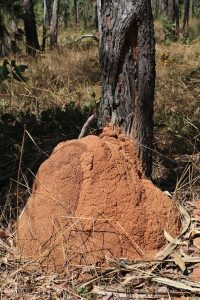The Lifecycle of Termites
The lifecycle of termites is divided into several stages, each crucial for the development and sustainability of a termite colony. Here’s a detailed look at these stages and their roles in the breeding process. Understanding the Breeding Habits of Termites
Egg Stage
The lifecycle of a termite begins with the egg stage. The queen termite, the primary reproductive member of the colony, lays thousands of eggs throughout her life. These eggs are cared for by worker termites, which maintain the optimal conditions needed for incubation.
Termite eggs typically hatch into nymphs after a few weeks or months, depending on the species and environmental conditions. During this incubation period, worker termites ensure that the eggs are protected and kept in a suitable environment for successful development.
Nymph Stage
After hatching, the eggs develop into nymphs. Nymphs are immature termites that will undergo several molts as they grow. This stage is critical as it determines the future role of each termite within the colony.

Nymphs eventually differentiate into various castes, including workers, soldiers, and alates. Worker nymphs take on tasks such as foraging for food, maintaining the nest, and caring for other termites. Soldier nymphs protect the colony, while alates are winged reproductive termites destined to leave the colony and establish new ones.
Reproductive Stage
The reproductive stage involves the emergence of alates, the winged termites responsible for colony expansion. Alates leave their parent colonies during specific times of the year, typically in large swarms. This nuptial flight allows them to find mates and establish new colonies.
After mating, alates shed their wings and become the new king and queen of a fledgling colony. The queen starts laying eggs, marking the beginning of a new lifecycle. The establishment of the new colony involves significant growth and development as the queen produces eggs and the colony expands.
Mating Behaviors of Termites
Termite mating behaviors are intricate and essential for the continuation of the species. These behaviors involve synchronized swarming, complex mating rituals, and the establishment of new colonies. Let’s explore these behaviors in detail.
Swarming
Swarming is a crucial behavior in termite reproduction. During a nuptial flight, alates leave their parent colonies in large groups to find mates. This event usually occurs under favorable weather conditions, such as warm and humid days following rainfall.
Swarming helps increase the chances of successful mating between individuals from different colonies. This genetic diversity is essential for the health and adaptability of new colonies. The synchronized nature of swarming also enhances the likelihood of finding a mate and establishing a new colony in a suitable location.
Mating Rituals
During the nuptial flight, termites engage in mating rituals mid-air. Once a suitable mate is found, the pair lands and begins the process of establishing a new colony. The male and female termites then shed their wings and seek out a suitable nesting site.
The mating rituals ensure that only the most viable pairs establish new colonies. This process involves selecting mates based on specific traits and behaviors, contributing to the overall fitness and success of the species.
Colony Establishment and Growth
After mating, the new king and queen start forming a new colony. The queen begins laying eggs, which are cared for by the king and worker termites. The initial stages of colony establishment involve creating a nest and developing various castes to support the colony’s growth.
The colony gradually expands as more eggs hatch into nymphs. Each caste plays a vital role in maintaining and growing the colony. Workers perform tasks such as foraging and nest maintenance, soldiers defend the colony, and alates eventually emerge to continue the cycle of reproduction.
Environmental Factors Influencing Termite Breeding
Environmental conditions significantly impact termite breeding and colony development. Understanding these factors can aid in managing termite populations and preventing infestations. Key environmental influences include temperature, humidity, and food availability.
Temperature and Humidity
Temperature and humidity are critical factors for termite breeding. Termites thrive in warm, moist environments, which are ideal for egg incubation and nymph development. High humidity levels help maintain the health of eggs and nymphs, while stable temperatures support the reproductive process.
Extreme temperature fluctuations or dry conditions can disrupt termite breeding and affect colony health. Effective pest management often involves controlling environmental conditions to make areas less attractive to termites.
Food Availability
Food sources, such as wood and cellulose materials, directly impact termite breeding. A plentiful food supply supports a larger workforce, which allows the queen to lay more eggs and sustain the colony’s growth.
Proper management of food sources is crucial in preventing termite infestations. This includes maintaining wooden structures and addressing moisture issues that could attract termites.
Colony Density and Competition
Colony density and competition with other termite colonies also influence breeding behaviors. In areas with high termite populations, colonies may produce more alates to increase their chances of finding mates and establishing new colonies.
Managing termite populations involves addressing issues related to colony density and competition. Targeted pest control measures can help reduce the number of active colonies and limit the spread of infestations.
Conclusion
Understanding the breeding habits of termites provides valuable insights into their role in ecosystems and helps in managing infestations. From the lifecycle stages and mating behaviors to environmental factors influencing reproduction, each aspect of termite breeding contributes to the colony’s success and growth. By gaining a comprehensive understanding of these processes, homeowners and pest control professionals can implement effective strategies for preventing and managing termite problems.


